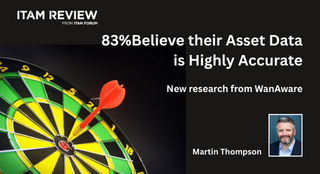Soooo much satisfaction - IT Job fulfilment reaches epic levels according to Torii State of IT Mind report
According to Torii‘s new “State of IT Mind Report,” 99% of IT professionals say they’re fulfilled in their jobs, and 94% feel appreciated by their companies.
However, despite these astronomical levels of fulfilment and job satisfaction, stresses around IT spend, cybersecurity, and outdated technology weigh on their minds. Despite the rising pressure to cut IT costs, 75% of CIO respondents say wasted SaaS spend remains a threat to their company – yet none feel they have good visibility into how much is actually spent on SaaS apps as well as an effective framework for evaluating whether these investments are worthwhile.

“IT teams play a key role in company success. It’s great to see they’re energized by their jobs. However, they need to be empowered to address major challenges,” said Uri Haramati, CEO of Torii. “Many IT teams are lean and don’t have the human or technology resources needed to keep on top of their ever-changing app landscape and its associated risks. As the State of IT Mind report makes clear, IT pros urgently need an easy way to gain visibility and insights so they can effectively manage spend and curtail risk.”

Key Findings from the Torii State of IT Mind Report
- Cybersecurity – the perennial threat – faces new competition from spend anxiety: Spend (cited by 61% of overall respondents), used to be lower on IT pros’ lists of concerns, but now it virtually ties with cybersecurity (62%). The fear that their organizations’ technology stacks lag behind competitors follows closely at 59%.
For CIOs in particular, SaaS spend is top of mind. Seventy five percent of CIOs say their inability to identify wasted SaaS spend is a threat to their company’s success.
- CIOs feel blind to SaaS spend management: Despite CIOs’ concerns, 73% say their organization does not have a strategic framework for evaluating app rationalization and license usage. Thirteen percent say they lack even basic visibility into SaaS spend – indicating that IT organizations need to invest in tools that give them this visibility and, at the very least, instruct teams to create frameworks for assessing and taking action on SaaS investments.
- IT isn’t confident in the methods they’re using to thwart cybersecurity threats: 50% of respondents point to leadership’s cybersecurity experience and awareness as a strong contributor to their company’s cybersecurity preparedness. However, only 27% cite cybersecurity systems and tools, and an even slimmer 16% say their companies are strong in training and education. This implies training must be more of a priority since employees are typically unwitting conduits for bad actors wanting to gain access to company networks and data.
- IT prefers centralized IT models. Sixty eight percent of respondents work in a centralized IT model – and 82% would prefer it – over having IT services embedded throughout their company. This could make it difficult for lean IT teams to scale and effectively manage their SaaS ecosystems when the majority of cloud apps are acquired via Shadow IT, unless they have tools that enable better visibility and distributed management.
Access the full Torii report
Torii surveyed 200 IT professionals about their job satisfaction and key challenges they face. To access the full “State of IT Mind” report, click here.
Other news from Torii
60% of IT Leaders Don’t Know Which Apps They Have: Torii SaaS report
69% of Tech Executives Say Shadow IT is Top Security Concern: Torii Study
Can’t find what you’re looking for?
More from ITAM News & Analysis
-
83% of IT Managers Believe their Asset Data is Highly Accurate - Only 35% of the Business Agrees
New and interesting research from WanAware hits at the nub of the disconnect many IT Asset Managers might feel about the value they deliver. The ‘Closing the ITAM Confidence Gap. 2025 Survey Insights for IT Leaders’ ... -
Microsoft Q4: Cloud and AI Results Drive Record Revenue
On 30th July 2025, Microsoft released its much-anticipated FY25 Q4 earnings report. The results follow a surprisingly strong Q3, which exceeded the expectations of some of the most optimistic investors. The latest Q4 results continue with ... -
10 Strategic Lessons for Tackling Compliance, Audits, and Software Licensing Risk in 2025
The ITAM Forum’s 2025 global ITAM research report in partnership with Azul reveals some fascinating insights into the financial, operational, and compliance risks involved in software licensing and audits. This article provides a high-level overview of ...
Podcast
ITAM training
Similar Posts
-
83% of IT Managers Believe their Asset Data is Highly Accurate - Only 35% of the Business Agrees
New and interesting research from WanAware hits at the nub of the disconnect many IT Asset Managers might feel about the value they deliver. The ‘Closing the ITAM Confidence Gap. 2025 Survey Insights for IT Leaders’ ... -
Microsoft Q4: Cloud and AI Results Drive Record Revenue
On 30th July 2025, Microsoft released its much-anticipated FY25 Q4 earnings report. The results follow a surprisingly strong Q3, which exceeded the expectations of some of the most optimistic investors. The latest Q4 results continue with ... -
10 Strategic Lessons for Tackling Compliance, Audits, and Software Licensing Risk in 2025
The ITAM Forum’s 2025 global ITAM research report in partnership with Azul reveals some fascinating insights into the financial, operational, and compliance risks involved in software licensing and audits. This article provides a high-level overview of ... -
Broadcom vs Siemens AG - A Brewing Storm
The ongoing legal battle between VMware (under Broadcom ownership) and Siemens is yet another example of why ITAM goes far beyond license compliance and SAM. What might, at first glance, appear to be a licensing dispute, ...




